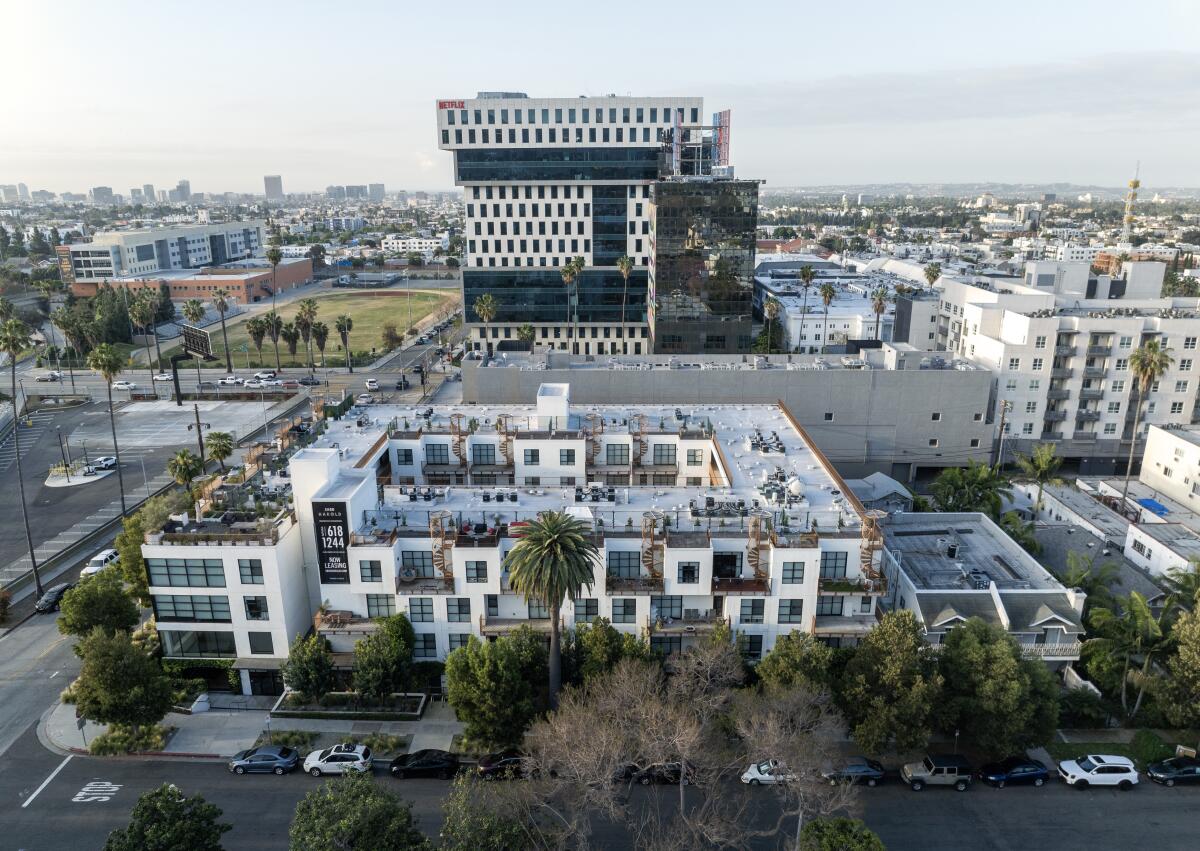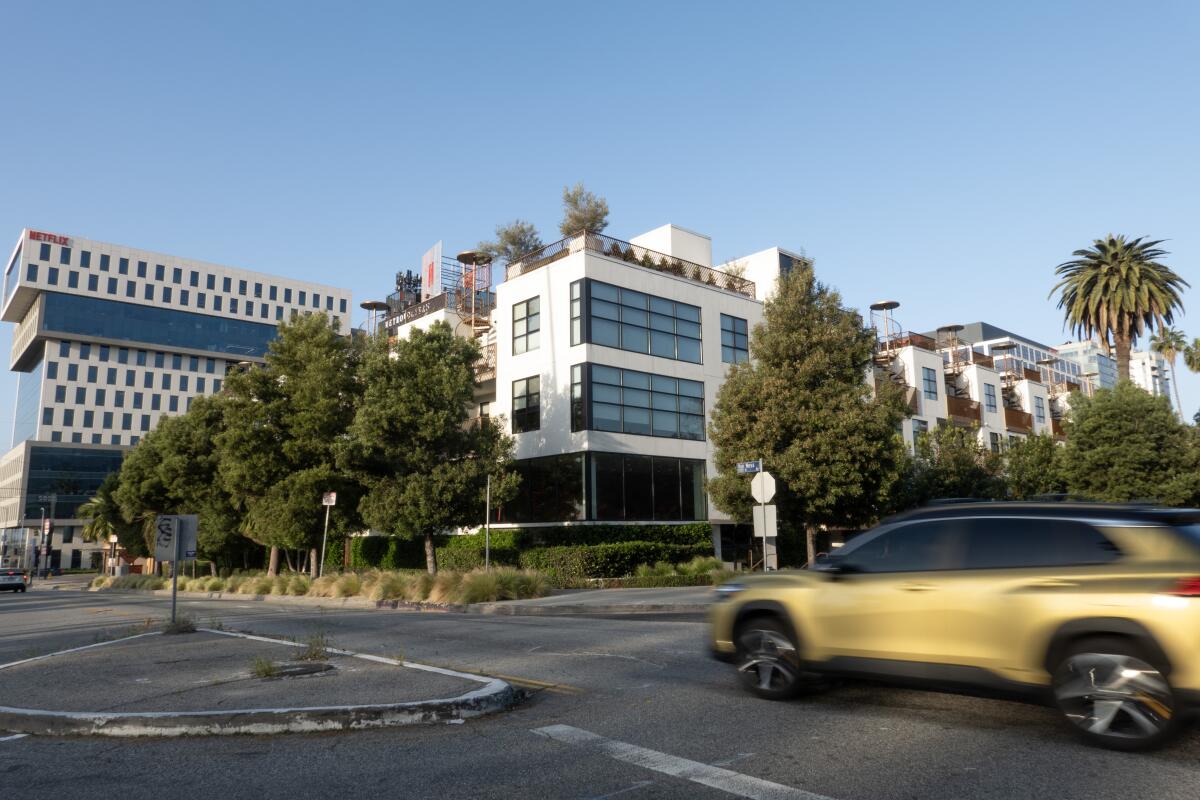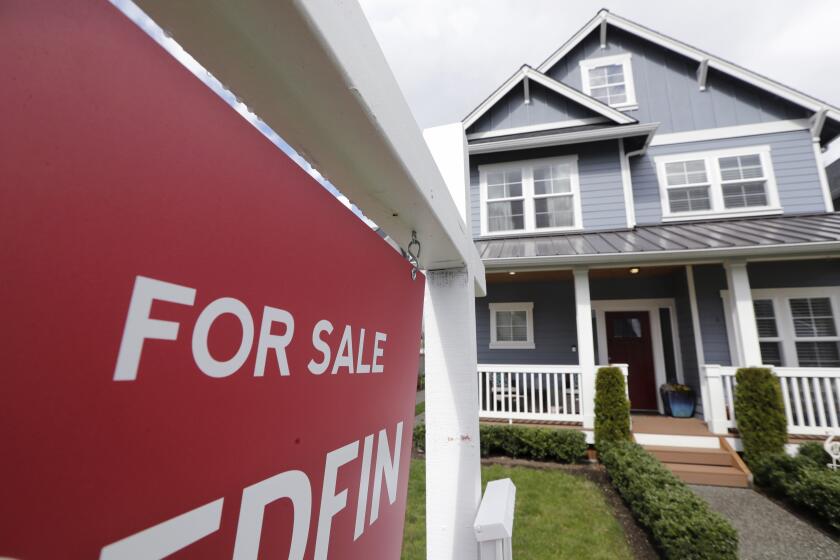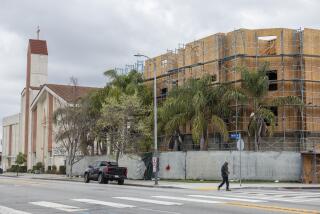In L.A., thousands of newer apartments have rent caps. Tenants don’t always know.

Alexa Castelvecchi was glad when she and her roommates found their new apartment about a year ago, in a modern building in Hollywood with a big, sleek kitchen and oversized windows. It was nothing like the aging, rent-controlled apartment she once sublet in Venice, where she often had to cook using a toaster oven.
But with the end of her lease on the three-bedroom apartment fast approaching, she has found herself worrying about how much the already high monthly rent of nearly $4,000 might increase.
Little did she know that she has some of the strongest protections available. Unbeknownst to many tenants across the city, an obscure city rule requires some newly built rental properties to be put under the city’s rent stabilization ordinance, commonly referred to as rent control.
Developers have built more than 10,000 such units since 2007, city records show, adding a new crop of rent-controlled housing across the city.
The buildings offer a counterpoint to real estate industry claims that rent control limits new construction. But they also raise a question: do their tenants even know they live in rent-controlled units?
Castelvecchi said she had no idea that she lived in a building with rent caps until a Times reporter told her recently.
“Nobody said anything,” she said.
Explore the latest prices for homes and rentals in and around Los Angeles.
Generally, the city’s rent control law only applies to buildings built on or before Oct. 1, 1978 — a cutoff date many landlords and at least some renters are acutely aware of. Under the rules, landlords can set the rent whenever a unit becomes vacant, but face limits on how much they can raise rent on individual tenants annually, usually between 3% and 8%, depending on inflation.
Newer buildings typically do not have those protections, but they can depending on what was there before. Under a 2007 city ordinance, newly constructed apartments, townhomes and condos must be rent controlled if an older rent controlled property was demolished on site.
The data show that developers across the city frequently pursue these projects despite their buildings being subject to rent caps the moment a lease is signed.

Leeor Maciborski, owner of ROM Residential, which currently owns Castelvecchi’s building, purchased that building after another investor built it. However, he said he’s developed five or six other properties in Los Angeles knowing they’d fall under the city’s rent stabilization ordinance.
The projects made financial sense because he could set the initial rent at market rate and was allowed at least a 3% increase each year, he said.
“If I could build something ... and I can count on 3% to 4% annual increases, I am happy,” the developer said.
Tenant advocates, meanwhile, say that even if some new rent-controlled apartments are being built, replacing older rent controlled units for new ones is devastating. Not only are people evicted, but new construction demands a premium when the unit is initially rented.
“The only ones who make out with this trade off is the developers and the landlords who are pulling in more and more profits and income on the backs of those people they have displaced,” said Larry Gross, executive director with the tenants advocacy group Coalition for Economic Survival.
Since mid-2007, owners have removed more than 13,000 older rent-controlled units from the market , leading to concern the demolition is worsening the city’s affordability and homelessness crisis.
Over the same time frame, housing department data show 10,252 new units have been put under the city’s rent stabilization ordinance.
New buildings can be exempt from the rules if they open for rent more than five years after the old property was removed from the market, or if the developer dedicates a certain number of new units as income-restricted affordable housing — though units will revert to rent control once those income restrictions expire in coming decades, according to the housing department.
About 3,000 additional units fall into the latter, temporarily exempt category, although some are already income restricted.
In theory, newly constructed rent-controlled properties could increase the overall number of apartments with rent caps in the city, because developers often knock down a small building to build more units. For now, that hasn’t happened.
The real estate industry — as well as many housing economists — have long argued that far fewer developers would build if they are subject to rent caps, leading to even higher rents as supply shortages worsen. As a result, rent control ordinances across the country typically exempt new construction.
Until recently, state law in California outlawed rent caps on properties built after Feb. 1, 1995, and even earlier in some cities like Los Angeles, with the exemption for newly built properties that replaced older rent controlled units.
Then in 2020, a new law took effect and put statewide rent restrictions on buildings older than 15 years, though these caps are less strict than in places like Los Angeles, whose rules remain in place.
The state bill’s author, then-Assemblyman David Chiu (D-San Francisco), had proposed 10 years as a cut off, but it was extended another five years to lessen opposition. At the time, the California Apartment Assn. took credit for the change, saying it would “mitigate the bill’s impact on future development of rental housing.”
Fred Sutton, a senior vice president with the California Apartment Assn., said the fact that some developers build under the L.A. rules does not mean housing construction would not decline if rent caps were placed on all new buildings. As restrictions are added, fewer projects can be expected to turn a reasonable profit — even if some go forward, he said.
“Can people still figure out a way to do it?” Sutton said. “Yes, but you’re not going to get as many people as you need.”
Two developers told The Times they didn’t know about the rules before building. One said he’d do so again, while another wouldn’t because rent control gives him less flexibility to earn a profit.
Maciborski said he’d take a different tack. He’d be willing to build another rent-controlled building, but only if the project would expect a greater return than before, to buffer him from potential actions by the Los Angeles City Council that might undercut his revenue stream.
The pandemic pushed the council to freeze rent in controlled buildings for nearly four years. Only a few months ago did officials allow landlords to raise rent.
“I’d consider it,” Maciborski said of constructing another rent-controlled property. “But now knowing what potential tools the city council ... has at their disposal, it’s definitely a little scarier.”
If you bought a home in the last two years with a high interest rate, did you purchase with the intention to refinance later? Tell us how the strategy has worked out so far.
Renters who live in any rent-controlled buildings — old or new — should know about it. The Los Angeles Housing Department requires the landlord to alert tenants by posting notice at the property. But several residents who spoke to The Times at the newer buildings said they had no idea.
After learning about her building’s status, Castelvecchi checked her lease and noticed that rent control is mentioned in a section she had previously overlooked. And she found a sign in the building outlining the rules, which she hadn’t previously noticed.
It would have been better, she said, if she had simply been told verbally about the rules when she rented the apartment.
“It’s extremely unnerving that it wasn’t communicated by anyone I met,” she said. “When you have to read the fine print, it feels difficult to trust.”
Maciborski said that if a tenant asked, a leasing agent would tell them if a building was rent controlled, but when dealing with legal issues his company relies on putting it in writing.
“It’s verifiable,” he said, adding written notices can also give more detailed information than a leasing agent may have on hand.
Gross, the tenant advocate, said it’s a constant struggle to educate tenants of their rights, with many residents of older properties not understanding they have rent control protections. He believes the problem is even worse in newer buildings, because even if people understand rent control exists they often believe all new properties are exempt.
“There’s not enough education and outreach,” Gross said.
Monique Mendoza, who pays $3,800 a month to live in a townhome in Boyle Heights, said she also had no idea that her newer unit also falls under the city’s rent control protections. It would have given her some relief just to know, she said. She is constantly worrying about the cost of rent and probably couldn’t afford a big increase.
Even without a rent hike, she said, “for us, as a family, it’s not affordable.”
More to Read
Sign up for Essential California
The most important California stories and recommendations in your inbox every morning.
You may occasionally receive promotional content from the Los Angeles Times.














